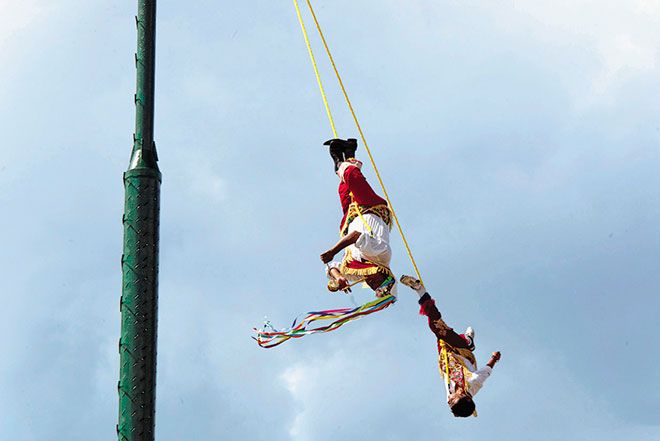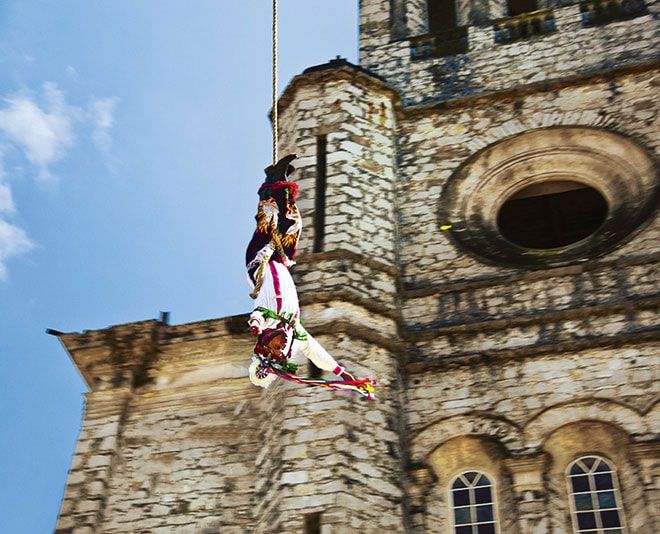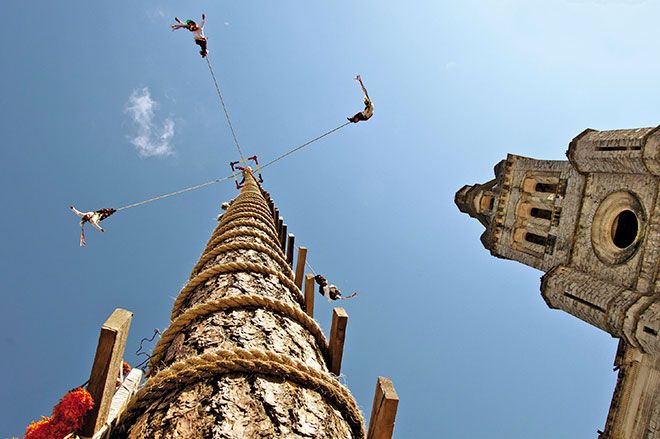The Dance of Flyers: An Ancient Mesoamerican Ritual
The dance of the flyers symbolizes the origin of the Earth, that is why the dancers revolve around the pole, just as the Earth revolves around the Sun.

The dance of the flyers is a lesson, ritually staged, that the native peoples of Mesoamerica have given to Western culture from the first intercultural contacts in the 16th century to the present day. In ancient Mexico, as among the original peoples in present-day Mexico, the collaboration between human work and the spiritual powers that inhabit nature is indispensable.
To activate this collaboration, ritual is necessary, which allows the confluence between human activities and the actions of the deities, who attend to the call that men and women have made through prayer, offering, sacrifice, dance, and music. The farmers prepare the land and sow it, but the germination and growth of the plants, the balance between the sun and the rains, is the work of the deities and the spiritual beings that propitiate a good harvest.
The ritual dances of flyers that we witness in our days come from very far back in time, as much as 2,600 years old, according to archaeological evidence from the pre-classic period found in Western Mexico, where the ritual is represented in small clay models, with a pole placed in the middle of a group of characters with ceremonial attire and at the top of which is a human figure with arms and legs outstretched in an attitude of flying.
Among the nine types of dances mentioned by the Dominican friar Diego Durán, all of them were practiced after prolonged training in schools, he refers to those who "used to dance around a high flyer, dressing as birds and other times as monkeys". Likely, the costume of "monkeys" that was used in the past is related to Xochipilli, the deity of dance, music, games, and flowers, one of whose invocations is precisely a monkey.

Dance of the flyers for spirits of the earth and corn
The dance had fallen into disuse in Xicotepec, but it was celebrated again when the Nahua people who inhabit that region considered that the fact of having abandoned it was the cause of the bad harvests that were obtained lately. They decided to practice again the dance of the flyers to give satisfaction to the "spirits of the earth and corn" so that the product of their crops would be more abundant again.
Before dancing, a nocturnal sacrifice of turkeys and chickens was made in a nearby cave. After the dance, the flyers ate in the house of one of the foremen of the feast. Each one of them was purified by smoking them with copal smoke and then pouring clean water on their hands. Once at the table, each dancer broke a tortilla into four portions, placing the pieces around his plate to indicate the four directions of the universe or cardinal points.
The solar cult among the ancient Mexicans implied the recognition of the star as a source of energy susceptible to depletion, hence the need to "feed" it with a fraction of human or animal energy that can be increased by elevating it to cosmic energy.
Unlike other cultural expressions, the dance was not prohibited by the Christian evangelizers during the colonial period, who saw it as a vital instrument for religious expression and integrated it into the Catholic ceremonial mixing native elements with the Hispanic-Arabic cultural complex coming from the Spanish peninsula.

The dance of the flyers as a spectacle
The dance of the flyers is celebrated everywhere once a year, preferably during the patron saint festivities. However, this does not exclude, given its alternately profane character, that it is performed on other festive occasions not necessarily religious or as a tourist spectacle.
Fasting, sexual abstinence, and the elimination of salt, chili, and other condiments in the scarce food are taboos that must be observed to be physically and spiritually prepared so that the dance can be performed without the risks caused by any ritual infraction. It is particularly important to say some prayers and present an offering to the instruments and accessories of the dance, from the choice and cutting off the appropriate tree in the forest.
Currently, the festival of "La Xochipila", which is celebrated on the day of San Juan Bautista in Xicotepec de Juarez, in the Northern Highlands of Puebla, is preserved a beautiful sculpture of a monkey carved in wood.
The everyday meals of the dancers and the offerings given to the deities, the dead, and the utensils used in the dance cover the three levels of the axis mundi: the sky, the underworld where the dead coexist with the seeds, and the earth inhabited by humans and their instruments.
After the ritual and placing the stick horizontally on the ceremonial patio, offerings are given as a sign of gratitude, both for its physical usefulness and for the service it has provided by allowing contact with spiritual forces and entities. Chocolate and turkey mole are offered to the spirits or angels and to the ancestors who invented the ritual.
Sources: Glockner J. El vuelo milenario. Elementos 122 (2021) 39-48




